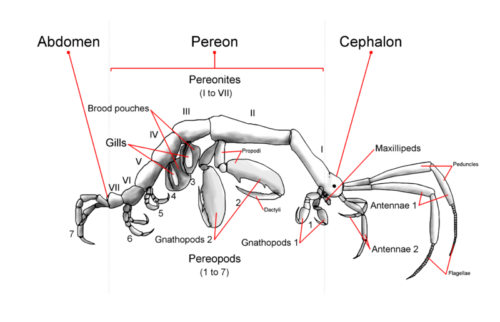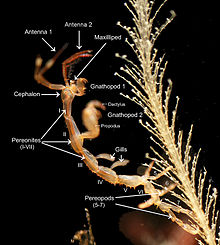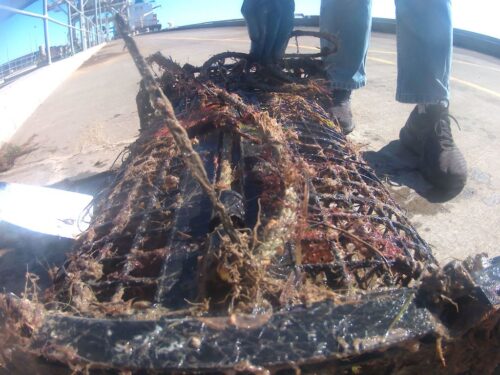There has been a recent revision of skeleton shrimp species following the discovery of thousands of skeleton shrimp on commercial fishing nets in the Gippsland Lakes in south-eastern Australia. The discovery led to the review of a species from Far East Asia, a review of previous records, and recognition of a new species.

File:Generalized caprellid (skeleton shrimp) body plan anatomy.png – Wikimedia Commons
This matter was reported by the Australian Museumj blog . It described skeleton shrimp as “small distinctive invertebrates that are classified in the superfamily Caprelloidea within the order of crustaceans known as the Amphipoda. …. Caprellids have been given the common name skeleton shrimp because they have narrow cylindrical bodies and reduced appendages that show extreme modification associated with a mode of life that is adapted to clinging to substrates.”
There are some photos, diagrams and video footage on the page. It goes on to describe how Matt Jenkins, a professional fisher, was surprised to find thousands of skeleton shrimp swarming his nets in Lake Tambo within the Gippsland Lakes, Victoria In 2018. This was a situation he (and his colleagues) had not encountered before.
The review found “consistent morphological differences between the Japanese and Australian samples”. The specimens from Japan were found to be twice the size of those from Australia. They also had “fewer segments in the first pair of antenna”. It was thought that, if they were the same species, they would have more segments. (“These appendages in caprellids have been shown to increase by one or two segments every time the individuals moult their exoskeleton as they mature.”)
The shape of the grasping limbs the caprellids use to feed and groom with were also different, and so too were the relative lengths of comparable segments in the antenna.
According to the Australian Museum blog, a new species has been proposed for the Australian specimens, with the name Caprella tamboensis.
Further, “It is still possible this species from the Gippsland Lakes and Tasmania may have been introduced to those areas but alternatively it could be a native species, widely distributed but as yet largely unrecorded in southern Australia.
“It has been highlighted in other recent publications that increased analysis of the caprellid amphipods from southern areas is needed to fill gaps in knowledge of the biodiversity and biogeographical patterns of the Australian fauna.
“Observations made in the redescription of C. acanthogaster and recognition of C. tamboensis also highlight that further detailed morphological study, possibly combined with genetic analysis, is necessary. This is important for reconstructing evolutionary relationships and for our understanding of the distribution pattern for C. acanthogaster and other species from temperate to cold waters of the northeast Asia – there are several in that region which are also very similar to C. acanthogaster and can be easily confused with it, so clarification is key!”
The report about the above study is:
A new species of Caprella (Crustacea: Amphipoda: Caprellidae) from Gippsland Lakes, Australia with a redescription of Caprella acanthogaster Mayer, 1890 from northern Japan. Records of the Australian Museum 74: 1–12. by Takeuchi I, Nagano K, Keable S., 2022.
Details about skeleton shrimp can be found on iNaturalist.

Skeleton Shrimp (Family Caprellidae) · iNaturalist
My own posts of skeleton shrimps found at Outer Harbor in 2019 & 2021 are posted on iNaturalist at
https://www.inaturalist.org/observations/20146008 and https://www.inaturalist.org/observations/92646846 .

Admittedly, as one of my colleagues commented, my photos don’t offer much clarity (“Hard to visualize! “). Another one of my colleagues posted this photo of their own at https://www.inaturalist.org/observations/50116431: –

(Photo taken by Catherine McMahon)
Again, this photo is hard to visualize, but it is better than my own!
There is a page (p.209) about skeleton shrimps in “A field guide to the marine invertebrates of South Australia” by Karen Gowlett-Holmes. It features 5 colour photos.

